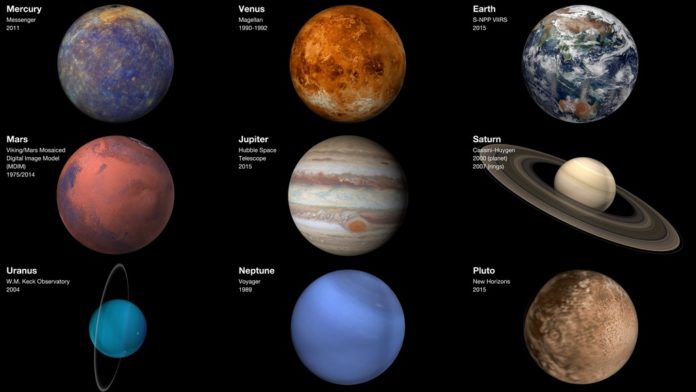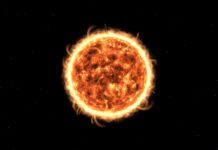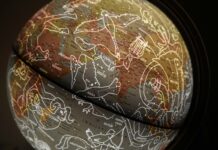Each planet represents a different part of life, a different energy. In psychology terms, they are considered your “needs” or “drives”. The personal planets are the Sun, the Moon, Mercury, Venus, and Mars. They are called fast-moving planets because they travel through the entire zodiac quickly.
If the proposed Resolution is passed, the 12 planet in our Solar System will be Mercury, Venus, Earth, Mars, Ceres, Jupiter, Saturn, Uranus, Neptune, Pluto, Charon and 2003 UB313. The name 2003 UB313 is provisional, as a “real” name has not yet been assigned to this object.

Earth:
Earth is the densest planet in the Solar System and the largest and most massive of the four terrestrial planets. Earth’s lithosphere is divided into several rigid tectonic plates that migrate across the surface over many millions of years. About 71% of Earth’s surface is covered with water, mostly by oceans.
Earth is the planet we live on. It is the third planet from the Sun. It is the only planet known to have life on it. The name derives from Old English and Germanic. There are, of course, hundreds of other names for the planet in other languages. In Roman Mythology, the goddess of the Earth was Tellus – the fertile soil (Greek: Gaia, terra mater – Mother Earth).
A ring system around a planet is also known as a planetary ring system. The most prominent and most famous planetary rings in the Solar System are those around Saturn, but the other three giant planets (Jupiter, Uranus, and Neptune) also have ring systems.
Thus plants using C4 photosynthesis may be able to survive for at least 0.8 billion years and possibly as long as 1.2 billion years from now, after which rising temperatures will make the biosphere unsustainable. Currently, C4 plants represent about 5% of Earth’s plant biomass and 1% of its known plant species.
Earth formed around 4.54 billion years ago, approximately one-third the age of the universe, by accretion from the solar nebula. Volcanic outgassing probably created the primordial atmosphere and then the ocean, but the early atmosphere contained almost no oxygen.
Luna commonly refers to: Earth’s satellite, the Moon in Latin. Luna (goddess), the ancient Roman personification of the Moon.
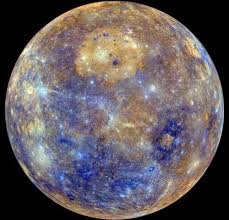
Mercury:
Mercury is the smallest and innermost planet in the Solar System. Its orbit around the Sun takes only 87.97 days, the shortest of all the planets in the Solar System. It is named after the Roman deity Mercury, the messenger of the gods. What Would It Be Like to Live on Mercury? Mercury’s extreme temperatures and lack of an atmosphere would make it very difficult, if not impossible, for people to live on the planet.
Mercury is not the hottest planet in the solar system. The hottest planet is Venus.) On its dark side, Mercury gets very cold because it has almost no atmosphere to hold in heat and keep the surface warm. The temperature can drop down to minus 300 degrees Fahrenheit.
Atmosphere. Instead of an atmosphere, Mercury possesses a thin exosphere made up of atoms blasted off the surface by the solar wind and striking meteoroids. Mercury’s exosphere is composed mostly of oxygen, sodium, hydrogen, helium and potassium.

Jupiter:
Jupiter is the fifth planet from the Sun and the largest in the Solar System. It is a gas giant with a mass one-thousandth that of the Sun, but two-and-a-half times that of all the other planets in the Solar System combined.
The temperature in the clouds of Jupiter is about minus 145 degrees Celsius (minus 234 degrees Fahrenheit). The temperature near the planet’s center is much, much hotter. The core temperature may be about 24,000 degrees Celsius (43,000 degrees Fahrenheit). That’s hotter than the surface of the sun!
There is no firm surface on Jupiter, so if you tried to stand on the planet, you sink down and be crushed by the intense pressure inside the planet. … If you could stand on the surface of Jupiter, you would experience intense gravity. The gravity at Jupiter’s surface is 2.5 times the gravity on Earth.

Mars:
Mars is a terrestrial planet with a thin atmosphere, having surface features reminiscent both of the impact craters of the Moon and the valleys, deserts, and polar ice caps of Earth. … Mars has two moons, Phobos and Deimos, which are small and irregularly shaped.
Mars is sometimes called the Red Planet. It’s red because of rusty iron in the ground. Like Earth, Mars has seasons, polar ice caps, volcanoes, canyons, and weather. It has a very thin atmosphere made of carbon dioxide, nitrogen, and argon.
The first attempts to reach Mars happened near the dawn of space exploration. Considering that the first satellite, the Soviet Union’s Sputnik, launched in 1957, it is extraordinary that only three years later the Soviet Union space program looked to extend its reach to Mars.
Human survival on Mars would require living in artificial Mars habitats with complex life-support systems. One key aspect of this would be water processing systems. Being made mainly of water, a human being would die in a matter of days without it.

Neptune:
Neptune is the eighth and farthest known planet from the Sun in the Solar System. In the Solar System, it is the fourth-largest planet by diameter, the third-most-massive planet, and the densest giant planet. Neptune is 17 times the mass of Earth, slightly more massive than its near-twin Uranus. After forming, denser diamonds would sink. This “diamond rain” would convert potential energy into heat and help drive the convection that generates Neptune’s magnetic field. There are some uncertainties in how well the experimental results apply to Uranus and Neptune.
Neptune’s cloud cover has an especially vivid blue tint that is partly due to an as-yet-unidentified compound and the result of the absorption of red light by methane in the planets mostly hydrogen-helium atmosphere.
Neptune’s atmosphere is made up of hydrogen, helium, and methane.

Venus:
Venus is the second planet from the Sun. It is named after the Roman goddess of love and beauty. As the second-brightest natural object in the night sky after the Moon, Venus can cast shadows and, rarely, is visible to the naked eye in broad daylight.
Venus would not be a pleasant place for people to live in the solar system. The planet’s active volcanoes and runaway greenhouse effect would make it a difficult place to survive. Between its desiccated, red-orange landscape and surface temperatures hot enough to melt lead, Venus is our solar system’s analog to hell.
The planet where it rains acid. … In reality it never rains sulfuric acid (at least not down to ground level) on Venus, because it evaporates before it has time to hit the ground – in fact, surface temperatures on Venus are hot enough to melt lead.
The atmosphere of Venus is made up almost completely of carbon dioxide. … The most Earth-like atmosphere in the solar system occurs 30 to 40 miles (50 to 60 kilometers) above the surface of Venus. Both oxygen and hydrogen rise above the heavier gas layer covering the ground, and the pressures are similar to our planet.

Uranus:
Uranus is the seventh planet from the sun and the first to be discovered by scientists. Although Uranus is visible to the naked eye, it was long mistaken as a star because of the planet’s dimness and slow orbit. The planet is also notable for its dramatic tilt, which causes its axis to point nearly directly at the sun. Uranus is made of water, methane, and ammonia fluids above a small rocky center. Its atmosphere is made of hydrogen and helium like Jupiter and Saturn, but it also has methane. The methane makes Uranus blue.
Uranus is the only planet whose equator is nearly at a right angle to its orbit, with a tilt of 97.77 degrees—possibly the result of a collision with an Earth-sized object long ago. This unique tilt causes the most extreme seasons in the solar system.
A collision with an Earth-sized object may explain the unique tilt. Nearly a twin in size to Neptune, Uranus has more methane in its mainly hydrogen and helium atmosphere than Jupiter or Saturn. Methane gives Uranus its blue tint.Discovered: March 13, 1781 by William Herschel.
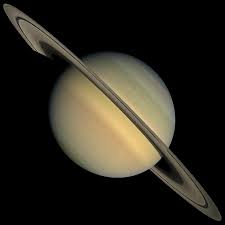
Saturn:
Saturn is the sixth planet from the Sun and the second-largest in the Solar System, after Jupiter. It is a gas giant with an average radius about nine times that of Earth. It has only one-eighth the average density of Earth; however, with its larger volume, Saturn is over 95 times more massive. The planet Saturn is probably the best known and most beautiful planet in the Solar System. Saturn’s rings are far more extensive and more easily seen than those of any other planet. Saturn is the second largest planet in the solar system with a diameter of 120,000 km.
Saturn and its rings are the jewel of the solar system, but the gas giant’s lack of a surface means humans won’t likely find a foothold there. Saturn’s moons Titan and Enceladus, however, might be better choices. Without a solid surface, Saturn isn’t likely a place we could ever live.

Ceres:
Ceres is the largest object in the main asteroid belt that lies between the orbits of Mars and Jupiter. With a diameter of 945 km, Ceres is both the largest of the asteroids and the only unambiguous dwarf planet inside Neptune’s orbit. It is the 25th-largest body in the Solar System within the orbit of Neptune.
Although it was still more than ten times as massive as the largest object in the asteroid belt, Ceres, it had one-fifth the mass of Earth’s Moon.
If Earth were the size of a nickel, Ceres would be about as big as a poppy seed. From an average distance of 257 million miles (413 million kilometers), Ceres is 2.8 astronomical units away from the sun. One astronomical unit (abbreviated as AU), is the distance from the sun to Earth.
1 Ceres is the largest exceptional asteroid by geometric mean diameter (946±2 km). The top 10 exceptional asteroids are: 1 Ceres, 4 Vesta, 2 Pallas, 10 Hygiea, 704 Interamnia, 52 Europa, 511 Davida, 87 Sylvia, 65 Cybele, 15 Eunomia.

Pluto:
Pluto is a dwarf planet in the Kuiper belt, a ring of bodies beyond the orbit of Neptune. It was the first Kuiper belt object to be discovered and is the largest known plutoid. Pluto was discovered by Clyde Tombaugh in 1930 as the ninth planet from the Sun.
In 2005, Eris, a dwarf planet in the scattered disc which is 27% more massive than Pluto, was discovered. This led the International Astronomical Union (IAU) to define the term “planet” formally in 2006, during their 26th General Assembly. That definition excluded Pluto and reclassified it as a dwarf planet.
Back in August 2006 astronomers voted to shake up the Solar System, and the number of planets dropped from nine to eight. Pluto was the one cast aside. There was some outcry that Pluto had been destroyed in an instant and was no longer important, and the reverberations were most keenly felt across America.
The spacecraft arrived at Pluto in July 2015, and will continue to study other objects in the Kuiper Belt from about 2018 to 2022. With New Horizons, we are visiting and learning about the objects at the very edge of our solar system. They may help us understand how our solar system formed.

Charon:
Charon, also known as Pluto I, is the largest of the five known natural satellites of the dwarf planet Pluto. It has a mean radius of 606 km. It was discovered in 1978 at the United States Naval Observatory in Washington, D.C., using photographic plates taken at the United States Naval Observatory Flagstaff Station .
Charon has a frigid surface, covered with methane and nitrogen ice, and possibly some water ice. Although Charon is mostly ice by mass, it may contain a small rocky core.
The remainder of the surface of the large moon is made up of water-ice, creating a grayish-white. Charon is more heavily cratered than Pluto, suggesting that the surface is older than its companion.
Charon is also often referred to as a spirit or a demon. Charon is the child of Nyx (Night) and Erebus (Darkness), both primordial gods. His existence predates that of even Zeus. … The largest moon of Pluto is named Charon after the Greek ferryman.
It was discovered in 1978 at the United States Naval Observatory in Washington, D.C., using photographic plates taken at the United States Naval Observatory Flagstaff Station (NOFS). With half the diameter and one eighth the mass of Pluto, Charon is a very large moon in comparison to its parent body.

2003 UB313 – Eris:
Originally designated 2003 UB313 (and nicknamed for the television warrior Xena by its discovery team), Eris is named for the ancient Greek goddess of discord and strife. The name fits since Eris remains at the center of a scientific debate about the definition of a planet.
The surface of the dwarf planet is grey, and astronomers believe that the surface is covered with methane ice, which is what causes it to appear grey. Methane is the same substance that makes Uranus and Neptune blue. The term “small Solar System body” is a new IAU definition to encompass all objects orbiting the Sun that are too small (not sufficiently massive) to satisfy the definition of planet or dwarf planet.
A day on Eris takes 25.9 hours. Eris has one moon, Dysnomia. Pluto, discovered in 1930, orbits the sun at an average of 39.5 times the Earth’s distance.
Views: 935


